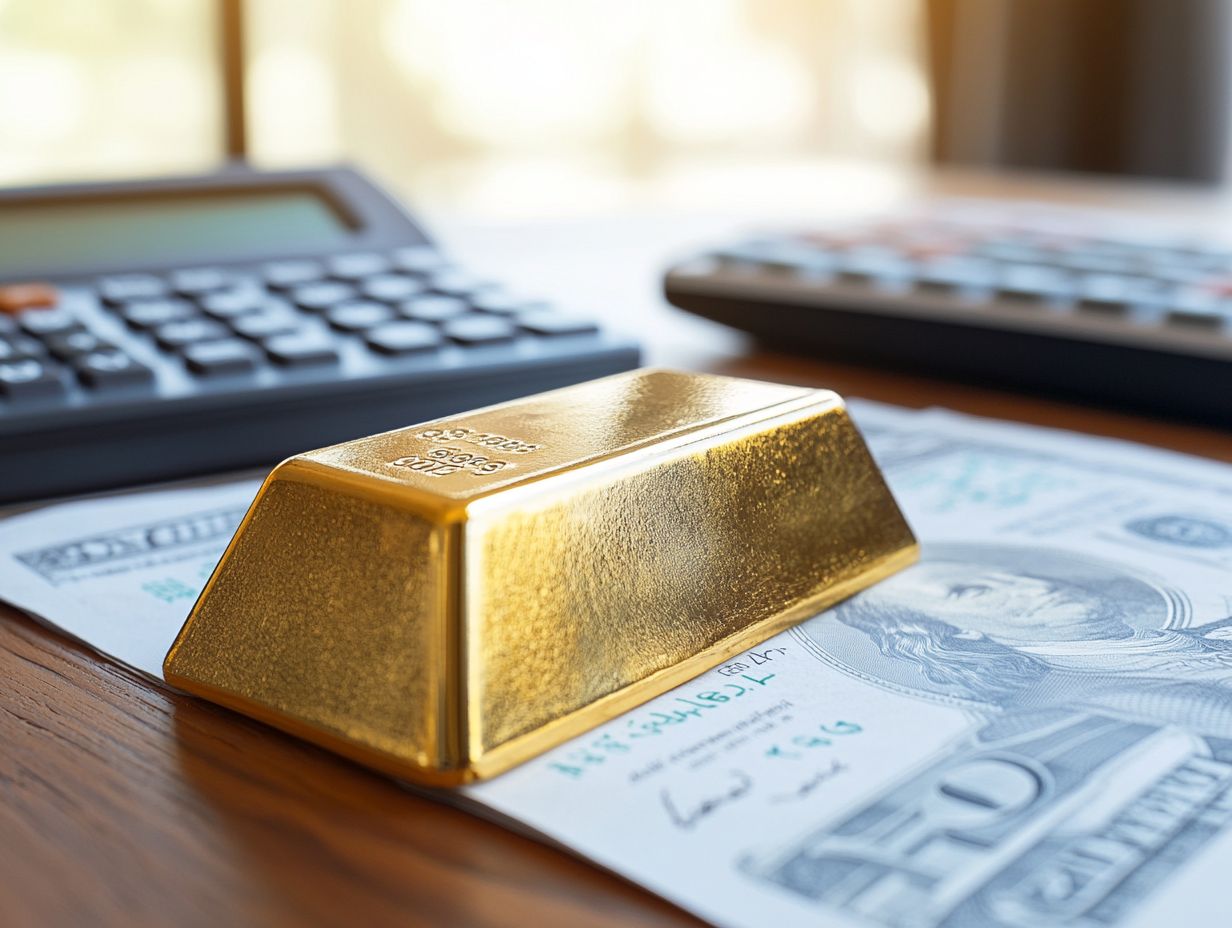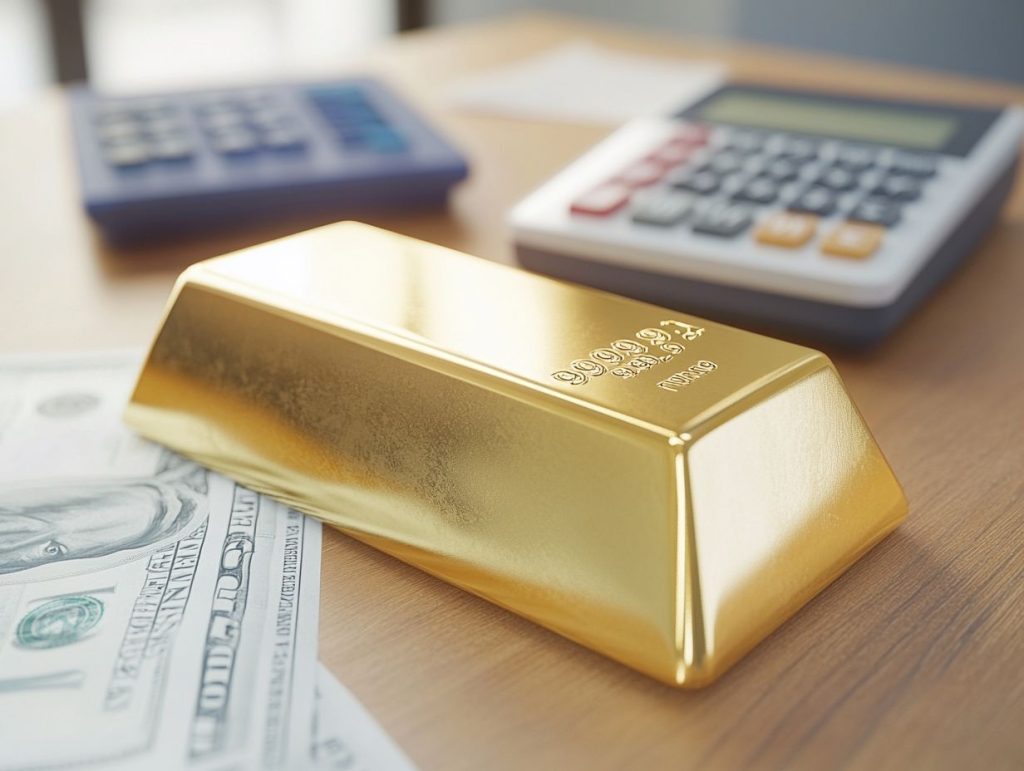Investing for retirement can be a daunting task, but incorporating gold into your self-directed IRA might offer unique advantages worth considering, especially in light of the 2023 economic outlook.
A Gold IRA is a type of retirement account that allows you to invest in physical gold and other precious metals, including bullion coins. Potential benefits include:
- Inflation protection
- Portfolio diversification
- Tax advantages
It’s essential to weigh these benefits against the risks and costs associated with Gold IRAs, including storage fees and IRS regulations. Whether you’re a seasoned investor or just starting, this information will help you evaluate if this option aligns with your financial goals and investment strategies.
Key Takeaways:
What is a Gold IRA?
A gold IRA is a specialized self-directed Individual Retirement Account (IRA) that permits investors to incorporate physical gold and other precious metals into their retirement savings, providing an alternative investment avenue outside traditional stocks and bonds, Roth IRAs, and SEP IRAs.
This type of account plays a crucial role in diversifying retirement portfolios by offering a hedge against inflation and market volatility, which conventional and Roth IRAs, primarily focused on paper assets, may not adequately address. Unlike traditional IRAs, which predominantly invest in stocks and bonds, a gold IRA specifically allows investors to hold tangible assets such as gold, silver, platinum, and palladium. In 2024, these features are expected to become even more significant due to heightened financial uncertainty.
It is essential to recognize that the Internal Revenue Service (IRS) has implemented strict regulations regarding the types of precious metals that can be included in a gold IRA, ensuring that they meet specific purity standards. These regulations enhance the integrity and stability of retirement investments, making gold a significant consideration for individuals seeking financial security in their later years. Consulting with a financial advisor can help navigate these complexities.
How Gold IRAs Work
Gold IRAs function through a distinct framework that incorporates the utilization of IRA custodians. These custodians oversee the account and ensure adherence to IRS regulations, including the use of an IRS-approved depository for asset custody.
Investors are permitted to select physical gold and other approved precious metals for their retirement accounts, which must be securely stored in an IRS-approved facility.
Benefits of Keeping Gold In an IRA

Investing in a gold IRA provides a range of advantages, including substantial diversification benefits for a retirement portfolio, potential tax advantages in comparison to traditional investment accounts, and the capacity to utilize gold as an effective inflation hedge.
This strategy aids in safeguarding wealth during economic downturns and periods of market volatility, making it a prudent choice for retirement savings.
Protection Against Inflation
Gold has historically functioned as a reliable hedge against inflation, maintaining its value over time and safeguarding investors from the detrimental effects of rising prices during economic downturns.
Throughout various economic cycles, including periods of hyperinflation and recession, this precious metal has consistently established itself as a safe-haven asset. For example, during the 1970s, when inflation rates in the United States reached unprecedented levels, the price of gold experienced a significant increase, underscoring its appeal among long-term investments and investors seeking stability.
In the current market environment, characterized by central banks worldwide implementing accommodative monetary policies and rising concerns regarding potential inflation, many investors are once again turning to gold as a means of preserving their purchasing power. This trend underscores gold’s role not merely as a commodity, but as a strategic long-term investment influenced by geopolitical tensions, currency fluctuations, and gold market dynamics.
Diversification of Investment Portfolio
Incorporating gold into an investment portfolio can significantly enhance diversification benefits, as its value often fluctuates independently of stocks and bonds, thereby providing a buffer against market volatility and economic uncertainty.
This characteristic is particularly relevant during periods of economic uncertainty, when traditional assets may undergo substantial fluctuations. Investors aiming to construct a balanced retirement portfolio should recognize that the inclusion of assets such as gold can offer protection against potential downturns in equity markets. Additionally, considering investment products like gold ETFs and gold mutual funds can further diversify and stabilize the retirement portfolio.
By allocating a portion of their investments to precious metals, individuals can effectively mitigate the risks associated with inflation and currency devaluation. Diversifying into gold stocks and other precious metals-related securities can further enhance the portfolio’s resilience.
This strategic approach not only aligns with a comprehensive investment framework but also fosters a sense of financial security, ultimately contributing to healthier long-term wealth accumulation.
Potential Tax Advantages

Gold IRAs present potential tax advantages, including tax-deferred growth and the opportunity for tax-free distributions, thus enhancing the overall return on investment for retirement savings and aligning with strategic investment decisions.
These tax benefits can be particularly favorable in comparison to traditional and Roth IRAs, where distributions are typically taxed as ordinary income or may be subject to specific withdrawal regulations. With a gold IRA, investors can not only protect their gains from immediate taxation but also maintain control over how and when they access their funds, often resulting in a more strategic investment approach. It’s important to understand contribution limits and consult with financial advisors to maximize these benefits.
Gold’s historical stability provides a hedge against inflation, making it an attractive option for individuals aiming to maximize the resilience of their retirement funds. A thorough understanding of these nuances in tax strategies can significantly impact overall retirement planning.
Risks and Drawbacks of Gold IRAs
Gold IRAs offer several advantages; however, they also entail inherent risks and drawbacks. These include market performance and the following factors:
- Susceptibility to market volatility
- Elevated fees related to storage and management
- Complexities that may affect investment decisions
Market Volatility
Gold prices can undergo significant fluctuations, influenced by various factors including economic uncertainty, geopolitical tensions, and shifts in investment demand. These variations present risks for individuals holding gold within an Individual Retirement Account (IRA) or other specialized accounts.
Such fluctuations can be particularly concerning for investors who seek stability in their portfolios, as they may result in unexpected losses or gains contingent upon market reactions. When economic indicators signal distress, such as increasing inflation or rising unemployment rates, the appeal of gold as a safe-haven asset often intensifies. Conversely, a stable economic outlook may suppress demand, leading to decreased prices.
Geopolitical events, including conflicts or trade disputes, can also prompt abrupt changes in market sentiment, requiring investors to reevaluate their gold holdings. Therefore, comprehending the interplay of these factors is essential for those aiming to mitigate risks while maximizing potential returns.
Higher Fees and Costs

Investing in a gold IRA typically incurs higher fees compared to traditional retirement accounts, including costs associated with the storage of physical gold and management fees charged by custodians.
These additional expenses can significantly influence the overall returns on investment, making it imperative for prospective investors to thoroughly understand them. Along with standard management fees that custodians may apply for account maintenance, there are often annual storage costs associated with the safekeeping of the physical gold. Additionally, investors should consider insurance costs to protect their gold holdings.
Depending on the selected storage facility, investors may also encounter setup fees or insurance costs designed to protect the gold from theft or damage.
Moreover, some custodians may impose transaction fees for each purchase or sale of assets, which adds another layer of expense that should be considered when evaluating the total cost of maintaining a gold IRA. A comprehensive assessment of these fees is essential for anyone contemplating this alternative investment strategy to ensure that it aligns with their financial objectives.
Alternatives to Gold IRAs
While gold IRAs provide unique advantages, investors have a range of alternatives to consider, including traditional IRAs, Roth IRAs, gold mutual funds, and gold ETFs, each offering distinct investment choices for retirement savings.
These options are designed to address various financial goals and tax circumstances, making them appropriate for different investor profiles. Traditional IRAs permit pre-tax contributions, which can decrease taxable income in the current year, with taxes applied upon withdrawal during retirement. Conversely, Roth IRAs are funded with after-tax dollars, allowing for tax-free withdrawals in retirement, which can be particularly beneficial for individuals anticipating a higher tax bracket in the future. Investors should also consider consulting with financial advisors to determine the best mix of investment options for their retirement accounts.
Gold ETFs offer exposure to gold without the need to hold physical assets, providing liquidity and ease of trading. These investment products include options such as gold mutual funds and precious metals-related securities. Each of these alternatives presents unique advantages and considerations, catering to investors with varying risk tolerances and investment strategies, including those looking for inflation hedge or diversification benefits.
How to Open a Gold IRA or Other Precious Metals IRA
Establishing a gold IRA involves a systematic setup process in which investors select a custodian, fund the account, and choose an IRS-approved depository for the storage of their physical gold and other precious metals. Options for these accounts often include self-directed IRAs managed by specialized IRA custodians.
The initial phase necessitates thorough research to identify a reputable custodian who specializes in self-directed IRAs and possesses expertise in the complexities of gold investments and precious metals IRAs. Once a suitable custodian has been identified, the investor must complete the requisite documentation to establish the account, followed by funding it, which is typically accomplished through a rollover from an existing traditional IRA or Roth IRA.
Upon funding the account, the subsequent step involves selecting a secure depository that adheres to IRS regulations, thereby ensuring the safe storage of the physical gold. Each of these steps demands meticulous attention to detail and a comprehensive understanding of compliance standards and contribution limits to uphold the tax-advantaged status of the account. Investors must also consider storage fees, tax advantages, and tax-deferred growth to maximize benefits.
Investors should also consult with financial advisors to make informed investment decisions and ensure their retirement portfolio is well-diversified. For more visuals and details, watch the video below:
